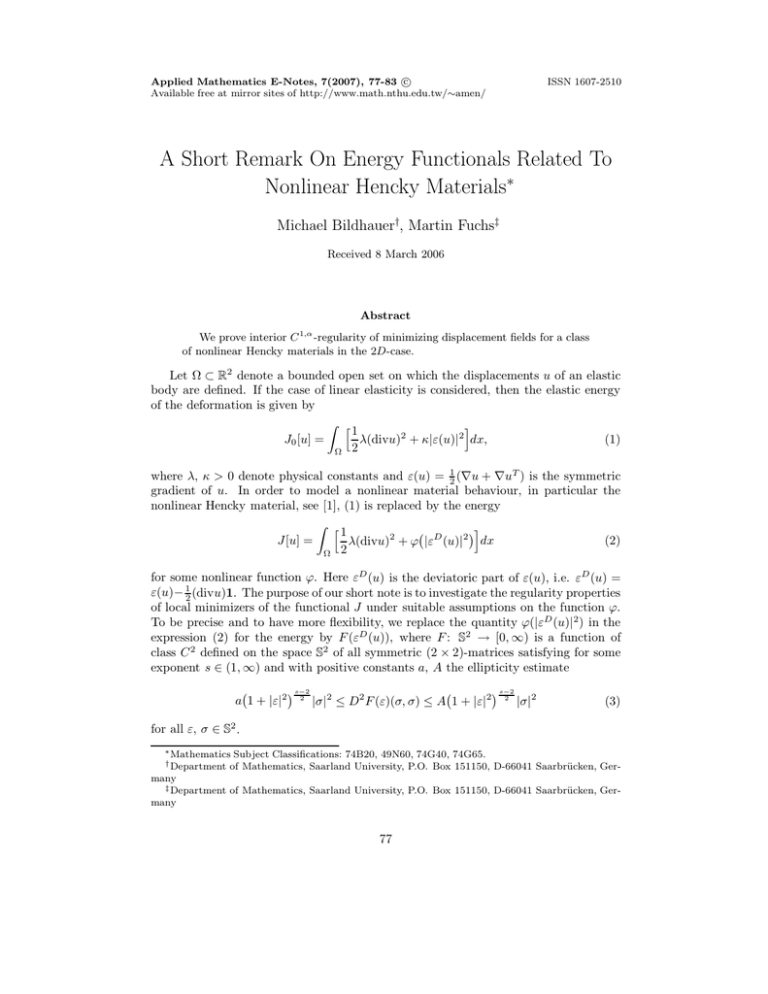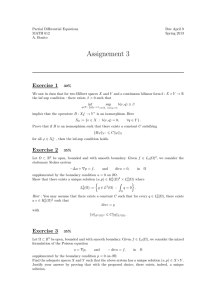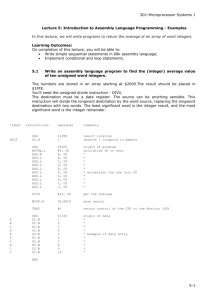Document 10677311
advertisement

c
Applied Mathematics E-Notes, 7(2007), 77-83 Available free at mirror sites of http://www.math.nthu.edu.tw/∼amen/
ISSN 1607-2510
A Short Remark On Energy Functionals Related To
Nonlinear Hencky Materials∗
Michael Bildhauer†, Martin Fuchs‡
Received 8 March 2006
Abstract
We prove interior C 1,α -regularity of minimizing displacement fields for a class
of nonlinear Hencky materials in the 2D-case.
Let Ω ⊂ R2 denote a bounded open set on which the displacements u of an elastic
body are defined. If the case of linear elasticity is considered, then the elastic energy
of the deformation is given by
Z h
i
1
J0 [u] =
(1)
λ(divu)2 + κ|ε(u)|2 dx,
Ω 2
where λ, κ > 0 denote physical constants and ε(u) = 12 (∇u + ∇uT ) is the symmetric
gradient of u. In order to model a nonlinear material behaviour, in particular the
nonlinear Hencky material, see [1], (1) is replaced by the energy
Z h
i
1
J[u] =
(2)
λ(divu)2 + ϕ |εD (u)|2 dx
Ω 2
for some nonlinear function ϕ. Here εD (u) is the deviatoric part of ε(u), i.e. εD (u) =
ε(u)− 12 (divu)1. The purpose of our short note is to investigate the regularity properties
of local minimizers of the functional J under suitable assumptions on the function ϕ.
To be precise and to have more flexibility, we replace the quantity ϕ(|εD (u)|2) in the
expression (2) for the energy by F (εD (u)), where F : S2 → [0, ∞) is a function of
class C 2 defined on the space S2 of all symmetric (2 × 2)-matrices satisfying for some
exponent s ∈ (1, ∞) and with positive constants a, A the ellipticity estimate
a 1 + |ε|2
s−2
2
|σ|2 ≤ D2 F (ε)(σ, σ) ≤ A 1 + |ε|2
s−2
2
|σ|2
(3)
for all ε, σ ∈ S2 .
∗ Mathematics
† Department
Subject Classifications: 74B20, 49N60, 74G40, 74G65.
of Mathematics, Saarland University, P.O. Box 151150, D-66041 Saarbrücken, Ger-
many
‡ Department of Mathematics, Saarland University, P.O. Box 151150, D-66041 Saarbrücken, Germany
77
78
Energy Functionals
1
(Ω; R2 ) is called a local
DEFINITION 1. A function u from the Sobolev class W1,loc
minimizer of the functional
Z h
i
λ
(4)
(divv)2 + F (εD (v)) dx
I[v, Ω] :=
Ω 2
1
iff I[u, Ω0] < ∞ and I[u, Ω0] ≤ I[v, Ω0 ] for all v ∈ W1,loc
(Ω; R2) such that spt(u − v) is
0
0
compactly contained in Ω , Ω being an arbitrary subdomain with compact closure in
Ω, spt denoting the support of a function.
Then we have
THEOREM 1. Let u denote a local minimizer of the functional I[·, Ω] defined in
(4) with F satisfying (3). Then u is in the local Hölder space C 1,α(Ω; R2 ) for any
0 < α < 1 provided that s ∈ (1, 4).
REMARK 1. In the case that s ≤ 2 the result from Theorem 1 in principle is a
consequence of the work of Frehse and Seregin [2] on plastic materials with logarithmic
hardening. They consider the function F (ε) = |ε| ln(1 + |ε|) but it is not hard to show
that their arguments actually cover the case of exponents s ≤ 2.
REMARK 2. For s ∈ (1, 2] the functional I[·, Ω] also serves as a model for plasticity
with power hardening, we refer to [3], [4] and [5]. It is worth remarking that Seregin
proved partial regularity in the 3D-case for the above mentioned range of exponents,
see e.g. [6], [7].
PROOF OF THEOREM 1. Let f(ε) := λ2 (trε)2 + F (εD ), ε ∈ S2. Here trε is the
trace of the matrix ε and εD = ε − 12 trε1. Clearly f: S2 → [0, ∞) is of class C 2 and
satisfies for all ε, σ ∈ S2
D2 f(ε)(σ, σ) = λ(trσ)2 + D2 F (εD )(σD , σD ).
(5)
If s ≥ 2, then (3) and (5) imply with positive constants ν and µ
ν|σ|2 ≤ D2 f(ε)(σ, σ) ≤ µ 1 + |ε|2
s−2
2
|σ|2
(6)
for arbitrary matrices ε, σ ∈ S2 . If 1 < s < 2, then we observe (see (3) and (5))
D2 f(ε)(σ, σ) ≥ λ 1 + |ε|2
s−2
2
(trσ)2 + a 1 + |ε|2
s−2
2
|σD |2
which follows from (1 + |ε|2)(s−2)/2 ≤ 1 and (1 + |ε|2)(s−2)/2 ≤ (1 + |εD |2)(s−2)/2. Thus,
for a suitable constant ν > 0 we find that
i
s−2 h
s−2
D2 f(ε)(σ, σ) ≥ ν 1 + |ε|2 2 |σD |2 + (trσ)2 ≥ ν 1 + |ε|2 2 |σ|2,
and (see again (3))
D2 f(ε)(σ, σ) ≤ λ(trσ)2 + A|σD |2 ≤ µ|σ|2
for some µ > 0. Putting together both cases by letting q := max{2, s}, p := min{2, s}
we deduce from (6) and the calculations following (6) that
α 1 + |ε|2
p−2
2
|σ|2 ≤ D2 f(ε)(σ, σ) ≤ β 1 + |ε|2
q−2
2
|σ|2
(7)
M. Bildhauer and M. Fuchs
79
is true for all ε, σ ∈ S2 with constants α, Rβ > 0. But in [8] we showed that any local
1
(Ω; R2) of the energy Ω f(ε(v))dx with f satisfying (7) is of class
minimizer u ∈ W1,loc
1,α
C
in the interior of Ω provided that the exponents p and q are related through the
condition
q < min(2p, p + 2).
(8)
Recalling the definitions of p and q it is immediate that the latter condition on p and
q holds for s ∈ (1, 4). The reader should note that in [8] all comparison functions
have to satisfy the incompressibility condition divv = 0 but of course the situation now
simplifies in comparison to [8] and all results remain valid if this condition is dropped.
REMARK 3. If Ω is a domain in R3 and if F satisfies (3), then local minimizers u
of the functional I[·, Ω] are of class C 1,α on an open subset Ω0 of Ω such that Ω − Ω0
is of Lebesgue measure zero, provided s < 10/3. This follows from the results in [9] if
again the incompressibility condition is neglected.
REMARK 4. If we replace the term λ2 (divu)2 in the functional (4) by an expression
like g(divu) with function g of growth rate r ∈ (1, ∞), then a regularity result like
Theorem 1 follows along the lines of [8] if we require (8) to hold with the choices
q := max{s, r}, p := min{s, r}.
Let us now partially remove the restriction that s < 4.
1
THEOREM 2. Suppose that u ∈ W1,loc
(Ω; R2) is a local minimizer of the energy
I[·, Ω] defined in (4), where F satisfies (3) for some exponent s ≥ 4. Then the first
derivatives of u are α-continuous functions in the interior of Ω for any α ∈ (0, 1),
provided we assume that divu ∈ Lsloc (Ω).
PROOF. We define the class
V := v ∈ L2 (Ω; R2) : divv ∈ L2 (Ω), εD (v) ∈ Ls (Ω; S2 )
1
being the subspace of W1,loc
(Ω; R2 ) on which the functional I is well defined. If v ∈ V
is compactly supported in Ω, then it follows from
I[u, sptv] ≤ I[u + tv, sptv], t ∈ R,
that
Z h
i
λdivu divv + DF (εD (u)) : εD (v) dx = 0.
(9)
Ω
For h ∈ R − {0} and k ∈ {1, 2} let
∆h w(x) :=
1
[w(x + hek ) − w(x)]
h
denote the difference quotient of the function w. For ϕ ∈ C0∞ (Ω) it is easy to check that
v := ∆−h (ϕ2∆h (u − P x)) is admissible in (9) for any constant matrix P . Following for
example the calculations carried out in [9], it is not hard to show that after passing to
the limit h → 0 the next inequality can be deduced (from now on summation w.r.t. k)
Z
D2 W (ε(u))(∂k ε(u), ∂k ε(u))ϕ2 dx
Ω
Z
≤ −
D2 W (ε(u))(∂k ε(u), ∇ϕ2 ∂k [u − P x])dx,
(10)
Ω
80
Energy Functionals
where
W (σ) :=
λ
(trσ)2 + F (σD ), σ ∈ S2 ,
2
being the symmetric product of tensors. In particular, all the derivatives of u occurring in (10) exist in the weak sense. Let
H := D2 W (ε(u))(∂k ε(u), ∂k ε(u))
12
and observe that H 2 ∈ L1loc (Ω) which can be justified in strength via difference quotient
technique but can be made plausible as follows: since we assume divu ∈ Lsloc (Ω), we
have
1
ε(u) = εD (u) + (divu)1 ∈ Lsloc (Ω; S2 ) ,
2
hence ∇u ∈ Lsloc (Ω; R2×2) by Korn’s inequality. If we apply the Cauchy-Schwarz
inequality to the bilinear form D2 W (ε(u)), we get
2
D W (ε(u))(∂k ε(u), ∇ϕ2 ∂k u)
1 1
≤ 2 D2 W (ε(u))(∂k ε(u), ∂k ε(u))ϕ2 2 D2 W (ε(u))(∇ϕ ∂k u, ∇ϕ ∂k u) 2 .
Applying this estimate on the r.h.s. of (10) (choosing P = 0 for the moment) and using
Young’s inequality we obtain
Z
2
2
ϕ H dx =
Z
Ω
ϕ2 D2 W (ε(u))(∂k ε(u), ∂k ε(u))dx
Ω
≤
≤
c
Z
|D2 W (ε(u))||∇ϕ|2|∇u|2dx
c
ZΩ
|∇ϕ|2(1 + |∇u|2) 2 dx < ∞
s
Ω
on account of our assumption. This “shows” the local integrability of the function H 2,
and a similar argument gives that the integral on the r.h.s. of (10) is well defined. Note
that H 2 ∈ L1loc (Ω) is equivalent to
div∂k u ∈ L2loc (Ω),
1 + |εD (u)|2
s−2
4
|∂k εD (u)| ∈ L2loc (Ω).
In fact, the definition of W implies for any ε, τ , σ ∈ S2
D2 W (ε)(τ, σ) = λ(trτ )(trσ) + D2 F (εD )(τ D , σD ),
thus
H 2 = λ|∇divu|2 + D2 F (εD (u))(∂k εD (u), ∂k εD (u))
(11)
M. Bildhauer and M. Fuchs
81
and therefore (11) is immediate. Moreover, we have
Z
2
D W (ε(u))(∂k ε(u), ∇ϕ2 ∂k [u − P x])dx
Ω
Z h
i
s−2
|∇divu||∇ϕ||∇u − P | + 1 + |εD (u)|2 2 |∇εD (u)||∇ϕ||∇u − P dx
≤ c
ZΩ
s−2
s−2
≤ c
1 + |εD (u)|2 4 |∇u − P ||∇ϕ| |∇divu| + 1 + |εD (u)|2 4 |∇εD (u)| dx
ZΩ
s−2
≤ c
1 + |εD (u)|2 4 |∇u − P |H|∇ϕ|dx.
Ω
Letting h := (1 + |εD (u)|2)(s−2)/4 and returning to (10) it is shown that
Z
Z
c
2
H dx ≤
hH|∇u − P |dx,
R B2R
BR
(12)
provided we choose ϕ ∈ C0∞ (B2R ), ϕ ≡ 1 on BR , |∇ϕ| ≤ c/R, where B2R is any
open disc with compact closure in Ω. Now (12) exactly corresponds to (2.4) in [8],
and with
γ := 4/3 we end up with (2.5) of [8], i.e. we deduce from (12) (choosing
R
P = −B2R ∇udx)
Z
−
"Z
H 2dx ≤ c −
BR
(Hh)γ dx
# γ1 "Z
−
B2R
|∇2u|γ dx
# γ1
.
(13)
B2R
Noting that
|∇2u| ≤ c|∇ε(u)| ≤ c(|∇divu| + |∇εD (u)|) ≤ cHh,
(13) turns into
"Z
2
−
H dx
BR
# γ2
Z
≤ c−
(hH)γ dx.
(14)
BR
But (14) is the starting inequality for applying Lemma 1.2 of [8], provided we let
d := 2/γ, f := H γ , g := hγ in the lemma. Note that as in Section 2 of [8] all the
assumptions of the lemma are satisfied since by (11)
s
1
Φ := 1 + |εD (u)|2 4 ∈ W2,loc
(Ω)
and therefore
Z
exp(βh2 )dx ≤ c(ρ, β) < ∞
Bρ
follows as outlined after (2.7) in [8]. We conclude from the lemma that (with a suitable
constant c0 )
Z
H 2 logc0 β (e + H)dx ≤ c(β, ρ) < ∞
Bρ
is valid for any β > 0 and all ρ < 2R. Finally, let σ := DW (ε(u)). Then
s−2
|∇σ| ≤ c |∇divu| + 1 + |εD (u)|2 2 |∇εD (u)| ≤ chH,
(15)
82
Energy Functionals
and we may proceed as in [8] (see the calculations after (2.11)) to combine the latter
inequality with (15) in order to get
Z
|∇σ|2 logα (e + |∇σ|)dx ≤ c(R, α)
(16)
BR
for any α > 0 (compare (2.11) of [8]). By results outlined in [10] (in particular Example
5.3) (16) shows the continuity of σ. Since ε(u) = (DW )−1 (σ), the continuity of ε(u)
follows as well. If v := ∂k u, k = 1, 2, then
Z
0=
D2 W (ε(u))(ε(v), ε(ϕ))dx
(17)
Ω
for all ϕ ∈ C0∞(Ω; R2 ), and (17) can be seen as an elliptic system with continuous
coefficients. Then we use Campanato-type estimates for systems with constant coefficients (see, e.g. [11]) combined with a freezing argument to deduce v ∈ C 0,α(Ω; R2),
0 < α < 1. A detailed proof can be found for example in [12], Corollary 5.1, where of
course the incompressibility condition can be dropped.
References
[1] E. Zeidler, Nonlinear Functional Analysis and its Applications, vol. IV, Springer,
Berlin, 1987.
[2] J. Frehse and G. Seregin, Regularity for solutions of variational problems in
the deformation theory of plasticity with logarithmic hardening. Proc. St. Petersburg Math. Soc. 5(1998), 184–222 (in Russian). English translation:
Transl. Amer. Math. Soc., II, 193(1999), 127–152.
[3] L.M. Kachanov, Foundations of the Theory of Plasticity, North-Holland Publishing
Company, Amsterdam-London, 1971.
[4] V. D. Klyushnikov, The Mathematical Theory of Plasticity, Izd. Moskov
Gos. Univ., Moscov, 1979.
[5] J. Necǎs and I. Hlaváček, Mathematical theory of elastic and elasto-plastic bodies: an introduction, Elsevier Publishing Company, Amsterdam-Oxford-New York,
1981.
[6] G. Seregin, On the regularity of weak solutions of variational problems in plasticity theory, Algebra i Analiz 2 (1990), 121–140 (in Russian). English translation:
Leningrad Math. J. 2(1991), 321–338.
[7] G. Seregin, On the regularity of minimizers of certain variational problems in plasticity theory, Algebra i Analiz 4(1992), 181–218 (in Russian). English translation:
St. Petersburg Math. J. 4(1993), 989–1020.
[8] M. Bildhauer, M. Fuchs and X. Zhong, A lemma on the higher integrability of
functions with applications to the regularity theory of two-dimensional generalized
Newtonian fluids, Manus. Math. 116(2005), 135–156.
M. Bildhauer and M. Fuchs
83
[9] M. Bildhauer, M. Fuchs, M., Variants of the Stokes Problem: the case of
anisotropic potentials. J. Math. Fluid Mech. 5(2003), 364–402.
[10] J. Kauhanen, P. Koskela and J. Malý: On functions with derivatives in a Lorentz
space, Manus. Math. 100(1999), 87–101.
[11] M. Giaquinta and G. Modica, Nonlinear systems of the type of the stationary
Navier-Stokes system, J. Reine Angew. Math. 330(1982), 173–214.
[12] D. Apushkinskaya, M. Bildhauer and M. Fuchs, Steady states of anisotropic generalized Newtonian fluids, J. Math. Fluid Mech. 7(2005), 261–297.






